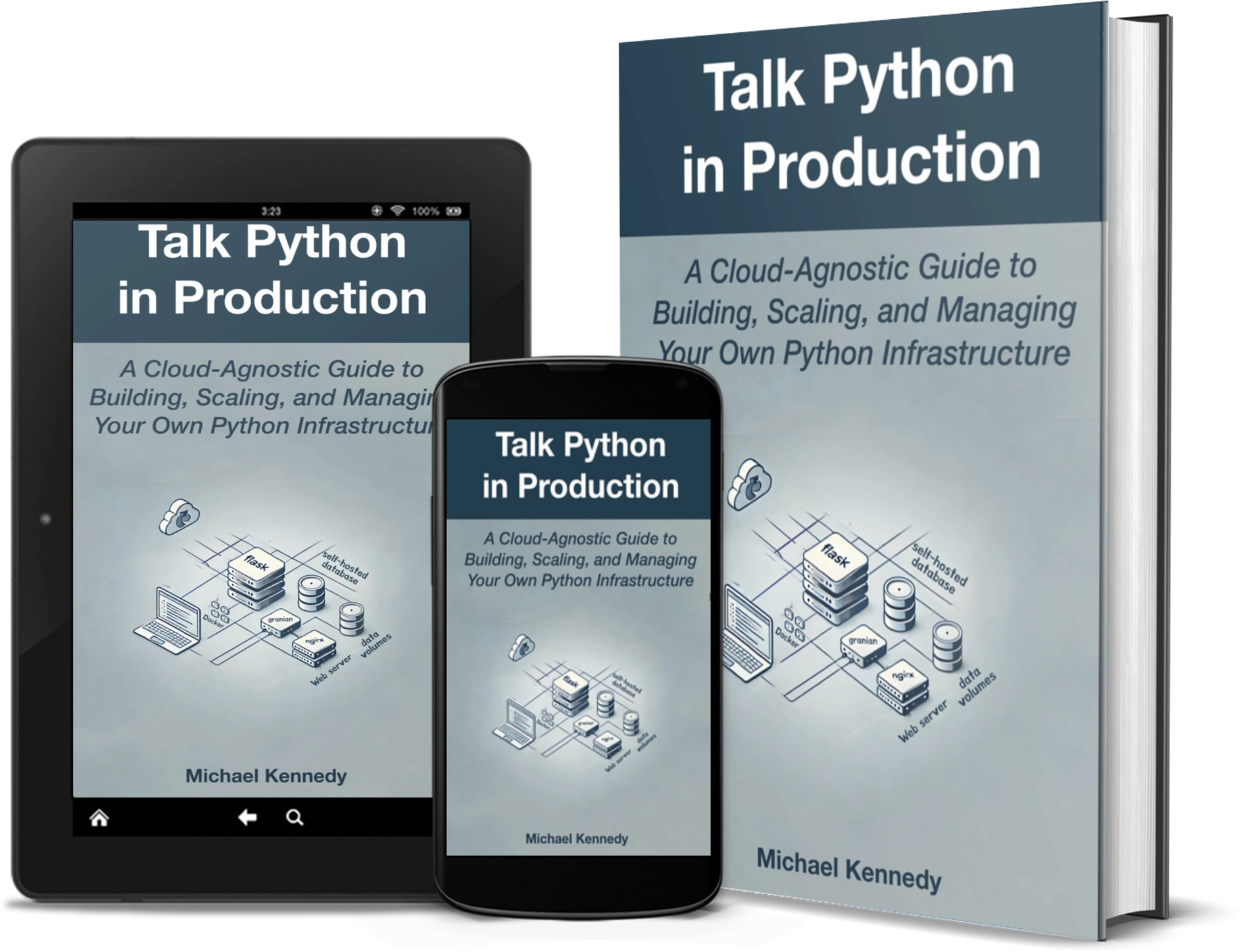I’m thrilled to share that my first solo book is published: Talk Python in Production.
Here’s the deal
Much of the advice we get about running our apps and APIs on the internet is overly complex. Many people and organizations are selling you this complexity. The hyperscale clouds see their lock-in of your app to their 100+ services as a golden ticket. And there are plenty of developers out there who see it as a flex and credibility boost to show how they are using the latest mix of these services regardless of whether they are the best fit.
Leonardo da Vinci knew that “Simplicity is the ultimate sophistication”. No, he never wrote a line of code. He never even vibe-coded an app. His advice still applies to software.
At its core, this book is two things:
- A story arc, 10 years in the making, of how I run Talk Python and the associated 20 or so services, APIs, and more today. I started as a total noob, apprehensive of Linux. Today, it’s a testament to how much can be accomplished as a very small team spending 100s of dollars, not $10,000s+.
- A detailed, step-by-step guide to transform your set of applications into simpler, lock-in-free infrastructure that is easily understandable and repeatable.
I hope you will join me on this journey.
More than your standard book
I’ve worked really hard to provide you with extra resources that most tech books ignore. Here are some extras that’ll help you get more out of Talk Python in Production:
- Code gallery: Contains all the code blocks from the book organized by chapter. Each code block is listed with its language and can be easily copied and used. No need to hunt through the book for code blocks. They are all in one place. This is in the book itself and on GitHub.
- Figure gallery: Ditto for images. But it’s even more important here. I’ve published the original max quality images that cannot be put into Kindle devices or would just be hard to see on many EPUB readers. This is in the book itself and on GitHub.
- Resources and Links Gallery: Contains all external links and resources referenced in the book. Links are organized by chapter for easy reference. Each link shows the text as it appears in the book along with the full URL. This is in the book itself and on GitHub.
- Discussion forum: A dedicated discussion forum where you can discuss ideas with other readers of the book.
- Audio Readers’ Briefs: The book includes a total of 1 hour and 20 minutes of short 2 to 4 minute conversations that bookend each chapter. Use them to prime your focus before reading or to broaden your takeaways after. Listen to an example.
How much of this book was written by AI?
Zero percent. This book is written entirely by yours truly over a period of 9 months. Yes, some of the artwork is AI-based. The code and prose is all mine. Don’t we live in wild times that this is even a question some people might ask?
What topics are covered?
- Early and evolving architectures: Real-world hosting journeys, from small PaaS approaches to robust multi-VM setups.
- One big server strategy: Why consolidating resources on a powerful VM can outperform many small nodes in practice.
- Docker & Docker Compose: Practical guides to containerizing Python apps, building images efficiently, and automating deployments.
- NGINX & Let’s Encrypt: Reverse proxy basics, SSL/TLS certificates, and best practices for production traffic and security.
- Self-hosted services: Tools like Umami (analytics) and Uptime Kuma (monitoring) that you can run yourself instead of paying for cloud solutions.
- Performance optimization: Setting up caching, using modern Python app servers, integrating a CDN, etc.
- Migrations & frameworks: Real-life examples of moving between frameworks (Pyramid to Quart) and cloud providers (PythonAnywhere to DigitalOcean and Hetzner).
- Stack-native philosophy: How to keep your infrastructure streamlined yet powerful and avoid the complexity of deeply “cloud-native” approaches.
Early reviews
I’m getting just a few early reviews and they are looking good:
⭐⭐⭐⭐⭐ 3 ratings on Gumroad (5-stars)
And a few folks have shared their feedback.
“I finished reading the book. I really enjoyed it. The massive hyperscale Kubernetes clusters everyone pushes today never made sense to me from a cost and complexity standpoint for the vast majority of cases.” – Paul
“This is a great book. I have used Python for 20 years. The book follows much of what I would do in my own judgment, and taught me some new tricks too.” – Chris
Give it a try
The book comes with a 30-day refund policy if you get it on Gumroad. You can easily give it a try for “no risk.” I hope you enjoy the book. And if you do get it, please send me a review to feature or share how it’s changed how you and your team run software (hopefully for the better!).
Regardless, thanks for the interest and supporting my work. Cheers.


